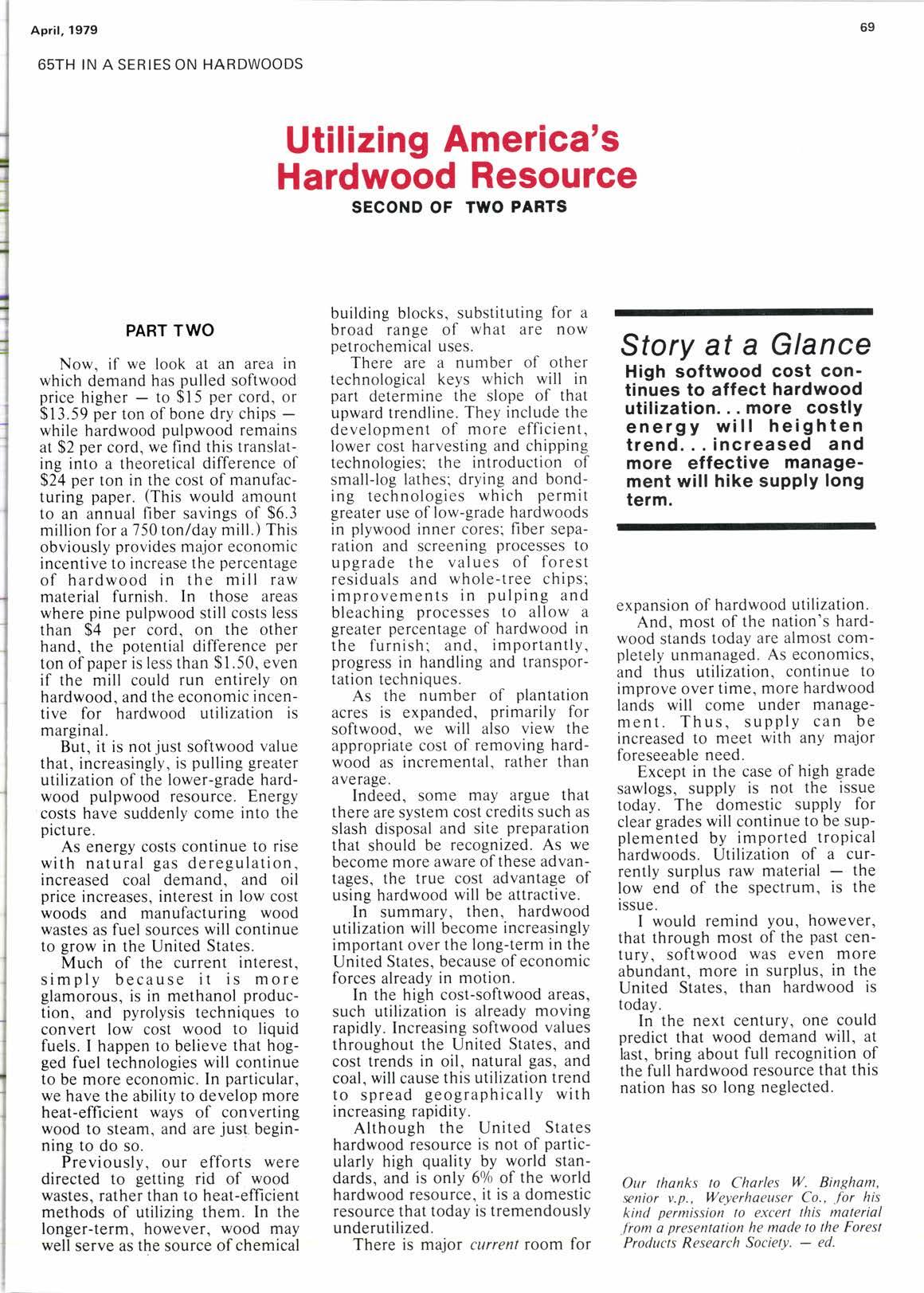
3 minute read
Utilizing America's Hardwood Resource
Second Of Two Parts
Part Two
Now, if we look at an area in which demand has pulled softwood price higherto $15 per cord, or $13.59 per ton ofbone dry chipswhile hardwood pulpwood remains at $2 per cord, we find this translating into a theoretical difference of $24 per ton in the cost of manufacturing paper. (This would amount to an annual fiber savings of $6.3 million for a 750 ton/day mill.) This obviously provides major economic incentive to increase the percentage of hardwood in the mill raw material furnish. In those areas where pine pulpwood still costs less than $4 per cord, on the other hand, the potential difference per ton ofpaper is less than $1.50, even if the mill could run entirely on hardwood, and the economic incentive for hardwood utilization is marginal.
But, it is not just softwood value that, increasingly, is pulling greater utilization of the lower-grade hardwood pulpwood resource. Energy costs have suddenly come into the picture.
As energy costs continue to rise with natural gas deregulation, increased coal demand, and oil price increases, interest in low cost woods and manufacturing wood wastes as fuel sources will continue to grow in the United States.
Much of the current interest, simply because it is more glamorous, is in methanol production, and pyrolysis techniques to convert low cost wood to liquid fuels. I happen to believe that hogged fuel technologies will continue to be more economic. In particular, we have the ability to develop more heat-efficient ways of converting wood to steam, and are jus't. beginning to do so.
Previously, our efforts were directed to getting rid of wood wastes, rather than to heat-efficient methods of utilizing them. In the longer-term, however, wood may well serve as the source of chemical building blocks, substituting for a broad range of what are now petrochemical uses.
There are a number of other technological keys which will in part determine the slope of that upward trendline. They include the development of more efficient, lower cost harvesting and chipping technologiest the introduction of small-log lathes; drying and bonding technologies which permit greater use of low-grade hardwoods in plywood inner cores; fiber separation and screening processes to upgrade the values of forest residuals and whole-tree chips; improvements in pulping and bleaching processes to allow a greater percentage of hardwood in the furnish; and, importantly, progress in handling and transportation techniques.
As the number of plantation acres is expanded, primarily for softwood, we will also view the appropriate cost of removing hardwood as incremental, rather than average.
Indeed, some may argue that there are system cost credits such as slash disposal and site preparation that should be recognized. As we become more aware of these advantages, the true cost advantage of using hardwood will be attractive.
In summary, then, hardwood utilization will become increasingly important over the long-term in the United States, because of economic forces already in motion.
In the high cost-softwood areas, such utilization is already moving rapidly. Increasing softwood values throughout the United States, and cost trends in oil, natural gas, and coal, will cause this utilization trend to spread geographically with increasing rapidity.
Although the United States hardwood resource is not of particularly high quality by world standards, and is only 60lo of the world hardwood resource, it is a domestic resource that today is tremendously underutilized.
There is major current room for
Story at a Glance
High softwood cost continues to affect hardwood utilization... more costly energy will heightentrend...increased and more effective management will hike supply long term.
expansion of hardwood utilization.
And, most of the nation's hardwood stands today are almost completely unmanaged. As economics. and thus utilization, continue to improve over time, more hardwood lands will come under management. Thus, supply can be increased to meet with any major foreseeable need.
Except in the case of high grade sawlogs, supply is not the issue today. The domestic supply for clear grades will continue to be supplemented by imported tropical hardwoods. Utilization of a currently surplus raw materialthe low end of the spectrum, is the issue.
I would remind you, however, that through most of the past century, softwood was even more abundant, more in surplus, in the United States, than hardwood is today.
In the next century, one could predict that wood demand will, at last, bring about full recognition of the full hardwood resource that this nation has so long neglected.
Our thanks to Charles W. Bingham, wnior v.p., Weyerhaeuser Co., .for his kind permission to excert this material from a presentation he made to the Forest Products Research Society.ed.










